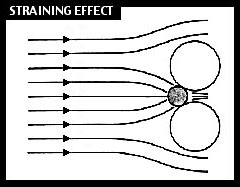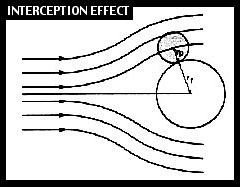|
Why Buy
C-vac?
C-vac PRODUCTS:
HEPA
Filters
Filter
Collection Bags
Prefilters
VACUUM BRAND:
Euroclean
Mastercraft
Minuteman
Nikro
Nilfisk
Pullman-Holt
Tornado
Kent
QUICK
SEARCH:
HEPA
TECHNOLOGY:
History
Efficiency
Construction
Testing
Principles
of Filtration
Particle
Sizes
OTHER:
Cross
Reference Index
Terms
of Use
Letter of Certification
Links
Contact C-vac
|
Principles
of Filtration:
At first glance one would think
that HEPA filter media, composed of an extremely large number
of randomly oriented micro-fibers, would
result in such minute pore sizes that scarcely any air could
pass through. Upon second glance, and after understanding that
air must pass through, one would think that the particles are
simply too large to fit through the jungle of fibers that make
up the media. In fact, HEPA media is approximately 92% air and
functions according to some fairly complex mechanical principles
and a combination of filtration mechanisms which makes the media
extremely effective on sub-micron particles. oriented micro-fibers, would
result in such minute pore sizes that scarcely any air could
pass through. Upon second glance, and after understanding that
air must pass through, one would think that the particles are
simply too large to fit through the jungle of fibers that make
up the media. In fact, HEPA media is approximately 92% air and
functions according to some fairly complex mechanical principles
and a combination of filtration mechanisms which makes the media
extremely effective on sub-micron particles.
There are four basic ways in
which fiberous air filters remove contaminants from the airstream
- the mechanisms of filtration:
|
1) Straining:
Straining, also refered to
as Sieving, is when particles are larger than the clearance between
the fibers. The particles can not pass through the opening and
are collected on the media.
|
 |
 |
2) Inertial Impingement:
Inertial Impingement, also
refered to as Impaction, relies on air flow velocity and particle
weight to cause particles to leave the airstream and impinge
(or impact) the fiber directly.
|
|
3) Interception:
Interception occurs when particles
small enough to follow the airstream around the fiber but are
intercepted by the fiber due to the dimension of the particle
radii being larger than the distance between the fiber and airstream
path the particle is following. The particle is held to the fiber
by a molecular surface attraction known as
Van der Waals' Forces.
|
 |
 |
4) Diffusion:
Diffusion, also refered to
as Super Interception, occurs on sub-micron particles which have
sufficiently low mass so that air molecules, which are continually
in motion and bombarding the particles, cause the particle to
travel in an erratic path. This motion increases the chance of
the particle coming in contact with the fiber. The smaller the
particle, the stronger the effect.
|
In the sequence listed above,
the mechanisms are increasingly important for decreasing particle
sizes. As particle size decreases the governing filtration mechanisms
switch with some overlapping of the effects. The most critical
lies between interception and diffusion. One can conceive of
particles small enough to follow the airstream around the fibers
and yet have enough mass that the molecular bombardment or "Brownian
movement" have but a slight effect. This then would represent
particle sizes which would be most penetrating and the filter
would exhibit its lowest efficiency when challenged with these
particles.
< Return to the Top >
History / Efficiency
/ Construction / DOP
Testing / Principles / Particle
Sizes
|